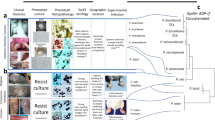Abstract
Staphylococcus cohnii strains isolated from various primates could be separated into three distinct groups or subspecies on the basis of phenotypic characterization and DNA-DNA hybridization techniques. These included a human-specificS. cohnii subspecies (denoted here as subsp. 1), a widely distributed primateS. cohnii subspecies (subsp. 2), and a Ceboidea (New World monkey)-specificS. cohnii subspecies (subsp. 3). Divergence of the latter subspecies from the other two is great enough to place it in a near (separate)-species status.S. cohnii represents the third example of aStaphylococcus species where DNA divergence has been demonstrated between human and nonhuman primate-adapted populations. The data presented in this report continue to support the hypothesis that at least certain staphylococci have evolved together with their hosts by conjugate evolution.
Similar content being viewed by others
Literature Cited
Benveniste, R. E., Todaro, G. J. 1977. Evolution of primate oncornaviruses: an endogenous virus from langurs (Presbytis spp.) with related virogene sequences in other Old World monkeys. Proceedings of the National Academy of Sciences, U.S.A.74:4557–4561.
Brenner, D. J., Fanning, G. R., Rake, A., Johnson, K. E. 1969. A batch procedure for thermal elution of DNA from hydroxyapatite. Analytical Biochemistry28:447–459.
Brooks, D. R. 1979. Testing hypotheses of evolutionary relationships among parasites: the digeneans of crocodilians. American Zoologist19:1225–1238.
Chiarelli, A. B. 1972. Taxonomic atlas of living primates. New York: Academic Press.
Clay, T. 1949. Some problems in the evolution of a group of ectoparasites. Evolution3:279–299.
Devriese, L. A., Hajek, V., Oeding, P., Meyer, S. A., Schleifer, K. H. 1978.Staphylococcus hyicus (Sompolinsky 1953) comb. nov. andStaphylococcus hyicus subsp.chromogenes subsp. nov. International Journal of Systematic Bacteriology28:482–490.
Hajek, V. 1976.Staphylococcus intermedius, a new species isolated from animals. International Journal of Systematic Bacteriology26:401–408.
Harrison, L. 1928. Host and parasite. Presidential address. Proceedings of the Linnaean Society of New South Wales53:(I):ix-xxxii.
Hegner, R. W. 1928. The evolutionary significance of the protozoan parasites of monkey and man. The Quarterly Review of Biology3:225–244.
Kellog, V. L. 1913. Distribution and species-forming of ectoparasites. American Naturalist47:129–158.
Kilpper-Balz, R., Schleifer, K. H. 1981. Transfer ofPeptococcus saccharolyticus Foubert and Douglas to the genusStaphylococcus: Staphylococcus saccharolyticus (Foubert and Douglas) comb. nov. Zentralbatt für Bakteriologie, Parasitenkunde, Infektionskrankheiten und Hygiene I Abt. Orig.C2:324–331.
Kloos, W. E. 1980. Natural populations of the genusStaphylococcus. Annual Review of Microbiology34:559–592.
Kloos, W. E., Musselwhite, M. S. 1975. Distribution and persistence ofStaphylococcus andMicrococcus species and other aerobic bacteria on human skin. Applied Microbiology30:381–395.
Kloos, W. E., Schleifer, K. H. 1975. Isolation and characterization of staphylococci from human skin. II. Descriptions of four new species:Staphylococcus warneri, Staphylococcus capitis, Staphylococcus hominis, andStaphylococcus simulans. International Journal of Systematic Bacteriology25:62–79.
Kloos, W. E., Schleifer, K. H. 1975. Simplified scheme for routine identification of humanStaphylococcus species. Journal of Clinical Microbiology1:82–88.
Kloos, W. E., Wolfshohl, J. F. 1979. Evidence for deoxyribonucleotide sequence divergence between staphylococci living on human and other primate skin. Current Microbiology3:167–172.
Kloos, W. E., Tornabene, T. G., Schleifer, K. H. 1974. Isolation and characterization of micrococci from human skin, including two new species:Micrococcus lylae andMicrococcus kristinae. International Journal of Systematic Bacteriology24:79–101.
Kloos, W. E., Musselwhite, M. S., Zimmerman, R. J. 1976. A comparison of the distribution ofStaphylococcus species on human and animal skin, pp. 967–973. In: Jeljaszewicz, J. (ed.). Staphylococci and staphylococcal diseases. Stuttgart: Gustav Fischer Verlag.
Kloos, W. E., Schleifer, K. H., Noble, W. C. 1976. Estimation of character parameters in coagulase-negativeStaphylococcus species, pp. 23–41. In: Jeljaszewicz, J. (ed.), Staphylococci and staphylococcal diseases. Stuttgart: Gustav Fischer Verlag.
Kloos, W. E., Schleifer, K. H., Smith, R. F. 1976. Characterization ofStaphylococcus sciuri sp. nov. and its subspecies. International Journal of Systematic Bacteriology26:22–37.
Mayes, M. A. 1973. Monogenetic trematodes from the Bluespot SunfishEnneacanthus gloriosus (Holbrook) in North Carolina. Transactions of the American Microscopical Society92:280–284.
Metcalf, M. M. 1928. Parasites and the aid they give in problems of taxonomy, geographical distribution, and paleogeography. Smithsonian Miscellaneous Collections81(8):1–36.
Sarich, V. M. 1970. Primate systematics with special reference to old world monkeys, pp. 175–226. In: Napier, J. R., Napier, P. H. (eds.), Old world monkeys: Evolution, systematics, and behavior. New York: Academic Press.
Schleifer, K. H., Kloos, W. E. 1975. Isolation and characterization of staphylococci from human skin. I. Amended descriptions ofStaphylococcus epidermidis andStaphylococcus saprophyticus and descriptions of three new species:Staphylococcus cohnii, Staphylococcus haemolyticus, andStaphylococcus xylosus. International Journal of Systematic Bacteriology25:50–61.
Starmer, W. T., Phaff, H. J., Miranda, M., Miller, M. W. 1978.Pichia amethionina, a new heterothallic yeast associated with the decaying stems of cereoid cacti. International Journal of Systematic Bacteriology28:433–441.
Zimmerman, R. J. 1976. Comparative zone electrophoresis of catalase ofStaphylococcus species isolated from mammalian skin. Canadian Journal of Microbiology22:1691–1698.
Zimmerman, R. J., Kloos, W. E. 1976. Comparative zone electrophoresis of esterases ofStaphylococcus species isolated from mammalian skin. Canadian Journal of Microbiology22:771–779.
Author information
Authors and Affiliations
Additional information
Paper No. 8555 of the Journal Series of the North Carolina Agricultural Research Service, Raleigh, N.C. 27650
Rights and permissions
About this article
Cite this article
Kloos, W.E., Wolfshohl, J.F. Deoxyribonucleotide sequence divergence betweenStaphylococcus cohnii subspecies populations living on primate skin. Current Microbiology 8, 115–121 (1983). https://doi.org/10.1007/BF01566968
Issue Date:
DOI: https://doi.org/10.1007/BF01566968




